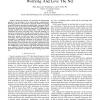22 search results - page 1 / 5 » Learning when to stop thinking and do something! |
ICML
2009
IEEE
14 years 5 months ago
2009
IEEE
An anytime algorithm is capable of returning a response to the given task at essentially any time; typically the quality of the response improves as the time increases. Here, we c...
CCR
2008
13 years 4 months ago
2008
The goal of this column this time was to address major scientific issues and propose novel scientific methods for doing the same thing under different names. However, it turned ou...
ACMDIS
2006
ACM
13 years 10 months ago
2006
ACM
Think-aloud testing is a widely employed usability evaluation method, yet its use in practice is rarely studied. We report an explorative study of 14 think-aloud sessions, the aud...
CSE
2009
IEEE
13 years 11 months ago
2009
IEEE
—When the Internet was conceived, its fundamental operation was envisioned to be point-to-point communication allowing anybody to talk directly to anybody. With its increasing su...
EICS
2009
ACM
13 years 11 months ago
2009
ACM
This paper discusses the use of formal methods for analysing human-computer interaction. We focus on the mode confusion problem that arises whenever the user thinks that the syste...


